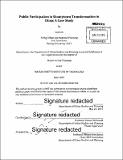Public participation in shantytown transformation in China : a case study
Author(s)
Lin, Luxi
DownloadFull printable version (11.26Mb)
Other Contributors
Massachusetts Institute of Technology. Department of Urban Studies and Planning.
Advisor
Ceasar McDowell.
Terms of use
Metadata
Show full item recordAbstract
Public participation is not a familiar concept in China but there is a growing demand from urban planners and policymakers in China to understand and utilize public participation tools. This research seeks to answer: How does the public participate in planning in China? What kind of participation is appropriate in China context? How do policymakers design for participation process in future planning projects? These questions are approached using qualitative methods such as field investigation, semi-structured interviews and policy document analysis. A case study on the use public participation in Baiwanzhuang to transform a shantytown in Beijing is the main lens for understanding participation in China. This is compared to the example of how participation was used in the Boston Demonstration Disposition program, another housing rehabilitation project. The author proposes a framework to explore the activities of participation that identifies and analyzes several phases of participation in each example to understand the differences between the two contexts. This research found that participation varies and that there are no uniform criteria of ideal participation for every context. To identify the appropriate participation, the context, goals and values must be understood. To do this, the author develops and uses a "Context-Value-Participation" model for "appropriate participation". This research also tries to summarize three main features of the China context development anxiety, elite governance and weak community. Policymakers in China can apply the "appropriate participation" model to China context when planning for future participation.
Description
Thesis: M.C.P., Massachusetts Institute of Technology, Department of Urban Studies and Planning, 2015. Cataloged from PDF version of thesis. Includes bibliographical references (pages 88-89).
Date issued
2015Department
Massachusetts Institute of Technology. Department of Urban Studies and PlanningPublisher
Massachusetts Institute of Technology
Keywords
Urban Studies and Planning.